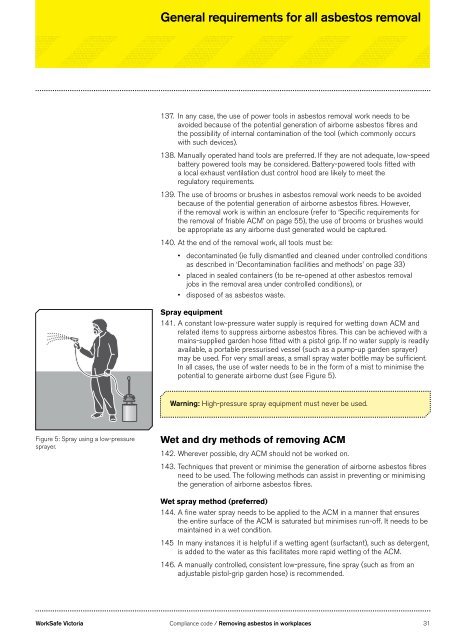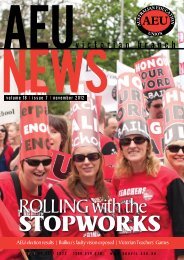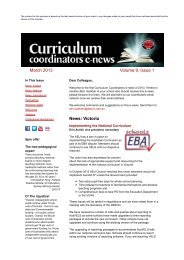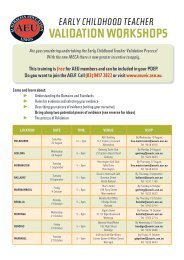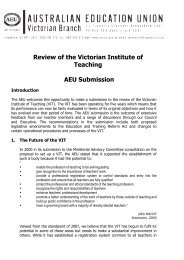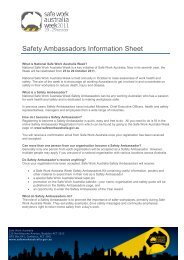Removing asbestos in workplaces - Compliance ... - WorkSafe Victoria
Removing asbestos in workplaces - Compliance ... - WorkSafe Victoria
Removing asbestos in workplaces - Compliance ... - WorkSafe Victoria
You also want an ePaper? Increase the reach of your titles
YUMPU automatically turns print PDFs into web optimized ePapers that Google loves.
General requirements for all <strong>asbestos</strong> removal137. In any case, the use of power tools <strong>in</strong> <strong>asbestos</strong> removal work needs to beavoided because of the potential generation of airborne <strong>asbestos</strong> fibres andthe possibility of <strong>in</strong>ternal contam<strong>in</strong>ation of the tool (which commonly occurswith such devices).138. Manually operated hand tools are preferred. If they are not adequate, low-speedbattery powered tools may be considered. Battery-powered tools fitted witha local exhaust ventilation dust control hood are likely to meet theregulatory requirements.139. The use of brooms or brushes <strong>in</strong> <strong>asbestos</strong> removal work needs to be avoidedbecause of the potential generation of airborne <strong>asbestos</strong> fibres. However,if the removal work is with<strong>in</strong> an enclosure (refer to ‘Specific requirements forthe removal of friable ACM’ on page 55), the use of brooms or brushes wouldbe appropriate as any airborne dust generated would be captured.140. At the end of the removal work, all tools must be:• decontam<strong>in</strong>ated (ie fully dismantled and cleaned under controlled conditionsas described <strong>in</strong> ‘Decontam<strong>in</strong>ation facilities and methods’ on page 33)• placed <strong>in</strong> sealed conta<strong>in</strong>ers (to be re-opened at other <strong>asbestos</strong> removaljobs <strong>in</strong> the removal area under controlled conditions), or• disposed of as <strong>asbestos</strong> waste.Spray equipment141. A constant low-pressure water supply is required for wett<strong>in</strong>g down ACM andrelated items to suppress airborne <strong>asbestos</strong> fibres. This can be achieved with ama<strong>in</strong>s-supplied garden hose fitted with a pistol grip. If no water supply is readilyavailable, a portable pressurised vessel (such as a pump-up garden sprayer)may be used. For very small areas, a small spray water bottle may be sufficient.In all cases, the use of water needs to be <strong>in</strong> the form of a mist to m<strong>in</strong>imise thepotential to generate airborne dust (see Figure 5).Warn<strong>in</strong>g: High-pressure spray equipment must never be used.Figure 5: Spray us<strong>in</strong>g a low-pressuresprayer.Wet and dry methods of remov<strong>in</strong>g ACM142. Wherever possible, dry ACM should not be worked on.143. Techniques that prevent or m<strong>in</strong>imise the generation of airborne <strong>asbestos</strong> fibresneed to be used. The follow<strong>in</strong>g methods can assist <strong>in</strong> prevent<strong>in</strong>g or m<strong>in</strong>imis<strong>in</strong>gthe generation of airborne <strong>asbestos</strong> fibres.Wet spray method (preferred)144. A f<strong>in</strong>e water spray needs to be applied to the ACM <strong>in</strong> a manner that ensuresthe entire surface of the ACM is saturated but m<strong>in</strong>imises run-off. It needs to bema<strong>in</strong>ta<strong>in</strong>ed <strong>in</strong> a wet condition.145 In many <strong>in</strong>stances it is helpful if a wett<strong>in</strong>g agent (surfactant), such as detergent,is added to the water as this facilitates more rapid wett<strong>in</strong>g of the ACM.146. A manually controlled, consistent low-pressure, f<strong>in</strong>e spray (such as from anadjustable pistol-grip garden hose) is recommended.<strong>WorkSafe</strong> <strong>Victoria</strong> <strong>Compliance</strong> code / <strong>Remov<strong>in</strong>g</strong> <strong>asbestos</strong> <strong>in</strong> <strong>workplaces</strong> 31


